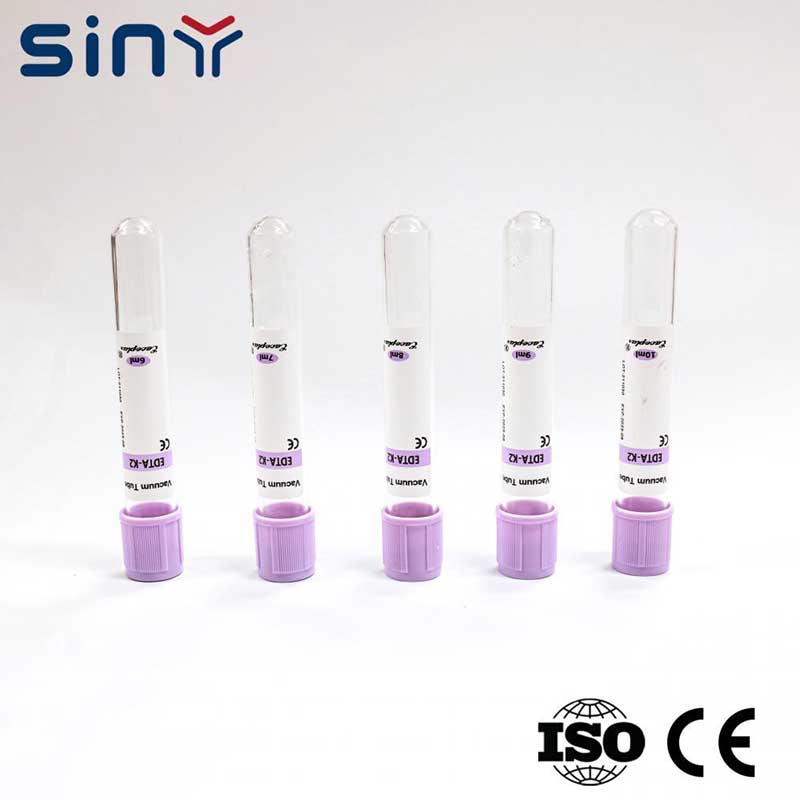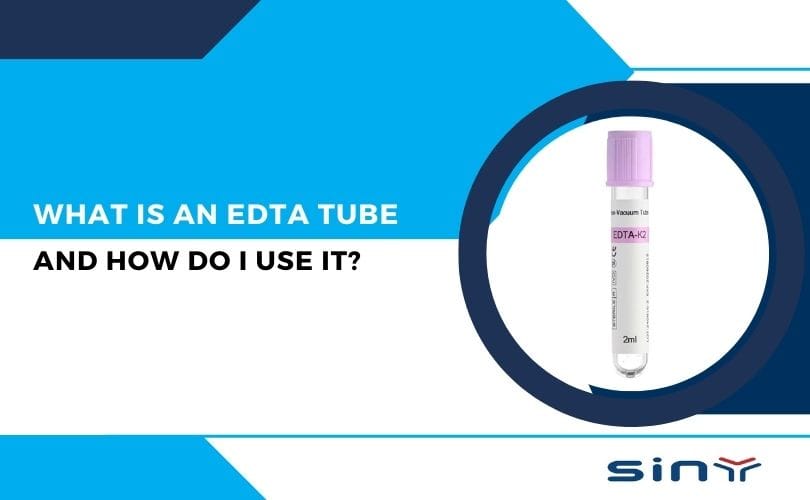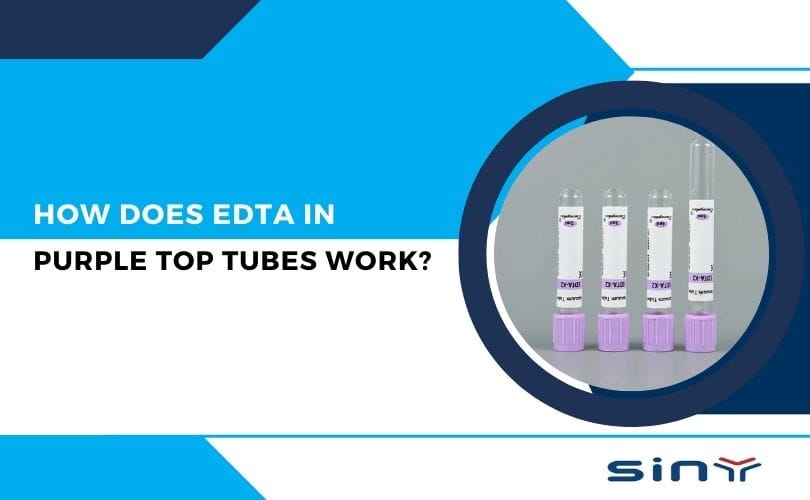EDTA tubes are specialized blood collection tubes containing Ethylenediaminetetraacetic acid (EDTA), a powerful anticoagulant. Blood Be Stored in EDTA Tubes works by binding calcium ions, preventing blood from clotting and preserving the morphology of blood cells. This makes EDTA tubes the preferred choice for hematological tests, including complete blood counts (CBC), blood smears, and more.
For a complete overview of EDTA tubes, their design, and their role in blood collection, visit EDTA Tubes for Blood Collection and Siny Medical’s EDTA Tubes.
What Are EDTA Tubes and Their Purpose?
EDTA (Ethylenediaminetetraacetic acid) tubes are specialized blood collection tubes containing an anticoagulant that prevents clotting by binding calcium ions. These tubes are widely used for:

- Complete Blood Count (CBC) – Essential for analyzing red blood cells, white blood cells, and platelets.
- Hematology testing – Including hemoglobin, hematocrit, and differential WBC counts.
- Molecular diagnostics – Such as DNA/RNA extraction for genetic testing.
Blood Stored in EDTA Tubes come in different sizes (e.g., 2 mL, 4 mL, 6 mL) and are identifiable by their lavender or pink tops. For more details on EDTA tube specifications, check our guide on EDTA Tubes for Blood Collection.
How Long Can Blood Be Stored in EDTA Tubes?
The storage duration of blood in EDTA tubes depends on the type of test being conducted. Below is a detailed breakdown:
Hematology Tests (CBC & Differential)
- Optimal Storage Time: 24–48 hours at room temperature (20–25°C)
- Extended Storage: Up to 72 hours at 4°C (refrigeration)
- Key Considerations:
- Morphological changes in blood cells (e.g., swelling, shrinkage) may occur after 48 hours.
- Platelet counts are particularly sensitive and should be analyzed within 6–8 hours for best accuracy.
For more on CBC testing with EDTA tubes, read our article: EDTA Tube Used for CBC.
Molecular Testing (DNA/RNA Extraction)
- Optimal Storage Time: Up to 7 days at 4°C
- Long-term Storage: -20°C or -80°C for months to years
- Key Considerations:
- Freeze-thaw cycles can degrade DNA/RNA, so aliquoting is recommended.
- EDTA stabilizes nucleic acids, making it ideal for PCR-based tests.
Blood Smears & Microscopic Analysis
- Optimal Storage Time: Within 2–4 hours
- Key Considerations:
- Delayed smearing can lead to cell distortion and inaccurate results.
Specialized Tests (Flow Cytometry, Immunophenotyping)
- Optimal Storage Time: 24–48 hours at 4°C
- Key Considerations:
- Antibody stability may decrease over time, affecting fluorescence-based assays.
For best practices in blood collection, visit: How to Properly Use EDTA Blood Collection Tubes.
What Are EDTA Tubes and How Do They Work?
EDTA stands for Ethylenediaminetetraacetic acid, a powerful anticoagulant that binds calcium in the blood, effectively preventing clotting. This property is crucial for tests that require whole blood rather than serum or plasma.
The most commonly used EDTA tubes are purple or lavender-top tubes. They’re preferred for hematological investigations, including:
Complete Blood Count (CBC)
Hemoglobin and Hematocrit Testing
White Blood Cell Differentials
Platelet Count
You can explore more about EDTA tubes for blood collection on EDTA Tube’s official product page.
Affecting Blood Storage in EDTA Tubes
Several variables influence how long blood remains viable in EDTA tubes:
Temperature Control
- Room Temperature (20–25°C): Best for short-term storage (24–48 hours).
- Refrigeration (4°C): Extends stability to 72 hours for most tests.
- Freezing (-20°C or -80°C): Required for long-term DNA/RNA storage.
Tube Fill Volume
- Underfilled tubes may lead to clotting due to insufficient EDTA.
- Overfilled tubes can cause hemolysis (rupture of red blood cells).
Sample Handling & Mixing
- Inadequate mixing can result in microclots.
- Excessive shaking may cause hemolysis.
For accurate blood collection techniques, see: Accurate Blood Collection with EDTA Tubes.
EDTA Tubes for CBC and Why They’re Preferred
For CBC testing, EDTA tubes are the go-to choice because they preserve the cellular structure better than other anticoagulants like heparin or sodium citrate.
They prevent clotting without causing cell shrinkage or affecting staining properties. This ensures accurate WBC counts, differentials, and platelet volumes.
Read more here: EDTA Tube Used for CBC
Applications of Blood Stored in EDTA Tubes
EDTA tubes are indispensable for:
Complete Blood Count (CBC)
Hemoglobin and hematocrit measurements
Blood film preparation
Molecular diagnostics (DNA/RNA testing)
Immunohematology
Learn more about EDTA tubes for CBC and their role in modern diagnostics.
FAQ
How long can blood be stored in EDTA tubes at room temperature?
Blood can be stored for up to 24 hours at room temperature before analysis. Beyond this, cell degradation may compromise results.
Can blood in EDTA tubes be refrigerated?
Yes, refrigeration (2–8°C) extends sample stability up to 48 hours. Always avoid freezing unless specifically required.
Is it safe to freeze blood in EDTA tubes?
Freezing is only recommended for certain analytes and for long-term storage. It can cause cell lysis and is not suitable for all tests.
What happens if blood is stored too long in EDTA tubes?
Prolonged storage leads to changes in cell morphology, hemolysis, and unreliable test results.
Where can I buy high-quality EDTA tubes?
Explore EDTA Tube’s product range and Siny Medical’s EDTA Tubes for trusted suppliers.
How do I ensure accurate blood collection and storage?
Follow best practices for sample handling, use quality tubes, and adhere to recommended timeframes. See How to Properly Use EDTA Blood Collection Tubes for guidance.
Where can I learn more about EDTA tubes and their applications?
Visit the EDTA Tube website and Siny Medical’s YouTube channel for resources, tutorials, and product information.
Wrapping It All Up
Blood stored in EDTA tubes remains stable for up to 24 hours at room temperature and 72 hours when refrigerated. However, certain tests like CBC, WBC differential, and platelet counts require fresh samples for best accuracy. Proper handling—from inversion, temperature control, labeling, and timing—is crucial to prevent sample degradation.
Whether you’re a clinician or lab pro, knowing how long blood can be stored helps avoid errors in diagnostics and improves patient care.
Need help choosing the right EDTA tube for your lab? Reach out via Contact Us at EDTA Tube







